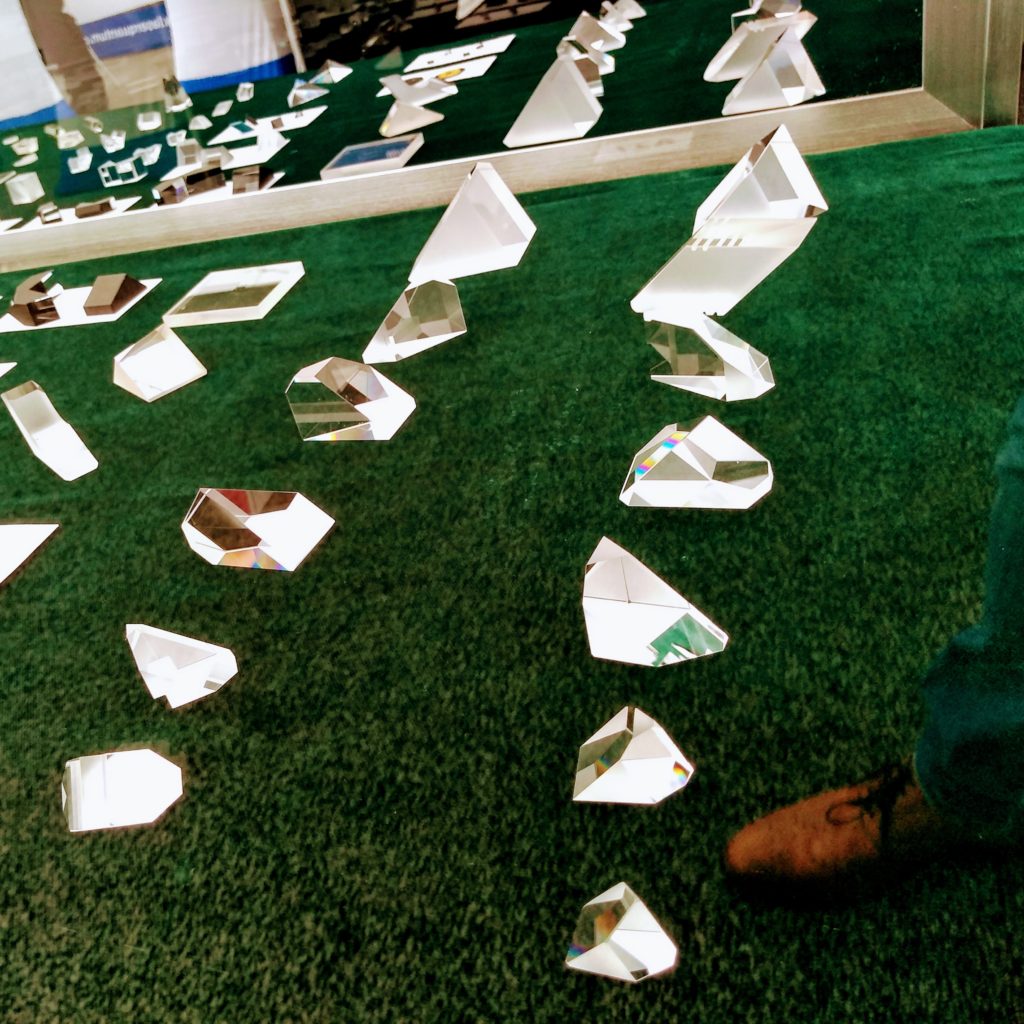Here are collected pictures from the vendor exhibition at the SPIE Optics+Photonics 2019 conference in San Diego, CA.
I always find these exhibitions strangely fascinating, and I wanted to capture why. Enjoy!


Continue reading
Here are collected pictures from the vendor exhibition at the SPIE Optics+Photonics 2019 conference in San Diego, CA.
I always find these exhibitions strangely fascinating, and I wanted to capture why. Enjoy!


The publication has a tremendous legacy, with writers such as Hannah Arendt (who published her series on the banality of evil there), James Baldwin who covered the civil rights movement and Susan Sontag who mused on various topics (see her collected articles in Against Interpretation and On Photography.)
I am speaking as a member of a certain democracy and a very complex country that insists on being very narrow-minded. Simplicity is taken to be a great American virtue along with sincerity. One of the results of this is that immaturity is taken to be a great virtue, too. – James Baldwin
New tandem read: how do new-yorkers @adamgopnik and @jiatolentino cope with with the mess were in. Long for Harriet Taylor and embrace the chaos of the modern self pic.twitter.com/DEh4a17BAd
— Antoine Wojdyla (@awojdyla) August 9, 2019
Wow the levy is about to break on Open Access!
I’ve written a few times on Open Access (here, and here), and things have been changing at an incredible pace.A quick explanation about the topic: scientists share their research by publishing into very specialized journals. These journals then either charge a fee (>$10) for any reader to read a specific article, or as is more often the case, collect a subscription for an institution so that all of the people who work for this institution get complete access to a journal or a set of journal. The problem here is that the research submitted by the authors is often funded by public entities, which do not have the right to read the publications of other group freely (open access.) And the subscription fees have skyrocketed (e.g. in the order of $10 million for UC Berkeley.)But now, large entities are rebelling.The first salvo came from funding agencies, which require the papers to be made freely available, either by sharing the pre-prints (e.g. on arxiv) or by publishing in an Open Access journal (journals where the authors pay (usually $1000!) to get published, and where anyone can read.)Then came Germany, which reached an impass with the academic publisher Elsevier (one of the leading actors, together with Springer and Wiley) and decided not to pay for the racket (projekt DEAL). The issue has not been resolved yet and German researchers still do not have access to publications such as Cell (they can however directly contact the authors of the papers to get the papers — which actually sound like a good way to start off collaborations!)Next is the University of California (the whole UC system, with UC Berkeley, Los Angeles, … including Lawrance Berkeley National Lab and Los Alamos), who decided not reneged a deal with Elsevier. That’s a lot of people, for the most important public university system in the world. The impact can be quite dramatic…And soon will be the turn of Europe as a whole, with Plan S, starting next year…I can’t wait to see the science literature being unshackled!Still, don’t expect much changes in the conduct of science… “Authors do not publish to get read, they publish to get reviewed.”@BerkeleySciRev maybe you should dispatch someone to Elsevier office on Milviahttps://t.co/7lV8Ao9vIA pic.twitter.com/41RMRIqF8X
— Antoine Wojdyla (@awojdyla) July 11, 2019
This is a compendium of the things I’ve learned discussing the issue with other trained scientists and running an association with many young researchers. This is not meant to be a comprehensive list, but should help with the discussion. This discussion is primarily based on gender imbalance, but intersectionality applies (sometimes in weird ways), though the case is not as thoroughly documented.
(I wrote this initially for colleagues in my organization, since I couldn’t find a good resource. Here’s a bunch of additional resources – Ideas In Action – that have sprung out since. I’d be very grateful if you could point me to other concise lists)* *
*
While in a democracy it should be obvious that laws should be made by a legislative body with balanced gender, one might notice that the representative democracy in America is not very representative (only 20% of US representatives are women, while roughly half of US constituents are indeed women), while there is no reason other than history to explain this imbalance.Though science is not a democratic process (there is no expressed need for equal representation), similar historical factors are at play, and diversity or lack thereof can cancel any competitive advantage in terms of science (see Marie Hicks) and inclusivity of technology (see Caroline Criado Perez.) Alleged differencesSome people will go as far as to say that women are actually undesirable in science, based on alleged differences in mental capacity (see Saini), or more subtly in the “variance” of the population (men supposedly show more variance, therefore more chances of fringe cases; see Strumia, Fig. 2)
Similar arguments from the Charles Murray’s racist book Bell Curve are used to promote borderline anti-semitic ideas – see also Jordan Peterson.Ahh! intersectionality…. Role modelsIt is important in order to bring more balance to have role models to whom young scientist can identify, ideally more recent (and more diverse) than Albert Einstein or Marie Curie. The role models should be invited to give talks on site, but ideally *not in the context diversity* — it is important not to fall in the Bechdel test trap, since (i) you will lose a lot of speaker who are tired of having to repeat again and again the many hurdles they faced (ii) these interventions are usually not very interesting outside the TED talk format (iii) the point of role models is to inspire to do science because of it, not in spite of it (that’s what we have experimented with Series X). MentorsSimilar to role models but closer to the person, it is important to have mentors, that can come naturally or through some kind of pairing. These mentors can provide help and support, through sharing their personal experience, advices, and promoting their mentees through invitations to talks and workshops (that’s what we experimented with forum@MSD and forum@ESA). Be careful that mentors should promote their mentee, not undermine them – the mentor should acknowledge the accomplishments of the mentee, not their own. Provide a platformGiven the current imbalance in gender and diversity as whole, we must make sure that people from underrepresented groups get invited to the lab and are being able to leverage this position, through announcements and support. Success begets success, and the lab is a good reference when someone wants to get booked in other places. Given that diverse speaker are paradoxically more rare, a budget must be set aside to fly them here and/or for an honorarium (they should not work for free, especially when they are themselves not in a position of power.)Scientists at the lab usually yield considerable power in their own field, and they should be encouraged to seek and promote diversity when they look for invited speakers (best practices and guidelines can be useful here, e.g. never have an all-male panel or seminar series.) Promote scientists to leadership positionAcademia is a very competitive environment, and any differentiating factor is useful when it comes to apply to position, especially when women face external factors that gradually push them outside academia (Fig. 1) Encouraging women to pursue ancillary activities (association, EAA or ERGs), where they can learn leadership skills and strengthen their network, is seen as important, and the lab should further its support to extra-curricular activities. Work-life balanceWork-life balance is a vague concept that still has very real implications: while men do not face the discrimination related to their potential being pregnant, women do. The consequence of childbearing should be shared between the two parents, and initiatives such as (non-gendered) parental leaves are very useful to bridge the gap.Some policies to make it more convenient to raise children can be implemented, such as policies against emails past 5pm during week-ends, or enforcing one day per week without meeting, to allow for telecommuting (parking at the lab is nearly impossible when an appointment to a doctor pushes your commute later in the day.) Smash the patriarchyOftentimes I hear people (old white male) arguing about the current push for equality, dismissed as a PC coup and a threat to the freedom of expression, where they feel that *they* might become victims. This is baloney, and they should learn about the distinction between men (them) and patriarchy (the system), and not feel threatened – this is not about them, it is about all of us. They might have to change their habits coming from a position of power they rarely acknowledge, and learn to speak up when they see something wrong.This applies to men… but also to women. I seen many times over ReferencesPaul Walton: Gender equality in Academia – what we have learntAngela Saini, Inferior: How Science Got Women WrongDaniel Kahneman, Thinking, fast and slowKatie O’Neal, Weapons of Math Destruction: How Big Data Increases Inequality and Threatens DemocracyMarie Hicks, Programmed Inequality: How Britain Discarded Women Technologists and Lost Its Edge in ComputingNearly half of US female scientists leave full-time science after first child, Nature, 19 February 2019https://www.nature.com/articles/d41586-019-00611-1?fbclid=IwAR2unznTjBTUUTlkEQJTiFmV6ZOxQUxTmhFQw_5j48r6YFXnHjoDoUEH2wMCaroline Criado Perez, Invisible Women: Exposing Data Bias in a World Designed for Men
Wikipedia is probably the best thing on Earth after sunsets, but it’s still far from perfect. Some articles are quite amazing, but oftentimes article about science topics or science personalities are nowhere near where they should be, and it seems that researchers should spend more time trying spread knowledge. Unfortunately, two things are in the way: the writers never get credit for it, and it’s bad optics in science to be the judge of notoriety for others.
It is amazing what you can accomplish if you do not care who gets the credit.
– Harry S Truman
Recently I became aware of an effort to improve the representation of scientists on Wikipedia, which is the go-to place to look up someone and evaluate their authority – in a world when men seems to preternaturally commend more than women. Let’s fix this!
 Here’s a few people for who I have started a page (I’ll keep this list updated as I go – yes, I do take credit, on a page no one will ever read in hopes this may inspire some wandering soul.)
Here’s a few people for who I have started a page (I’ll keep this list updated as I go – yes, I do take credit, on a page no one will ever read in hopes this may inspire some wandering soul.)
Translations
Scientific Topics:
Also, if you wonder what other people will think of you for doing the right thing, remember:
To say that someone is virtue-signalling amounts to an accusation of insincerity and performativity: saying or doing the (ostensibly) “right” thing, for the wrong moral reasons–e.g., gaining power. In response, say no, I’m quite sincere. And there are easier ways to get power.
— Kate Manne (@kate_manne) January 20, 2019
Back in undergrad, I remember being fascinated by the notion of Kolmogorov complexity in computer science.
Put simply, the Kolmogorov complexity is the minimal length (number of lines) of the code needed to generate a signal, would it be a mathematical sequence (such as one listed in the OEIS) or an image, irrespective to the size needed to store it. It bears deep relations with the notion of entropy (a great book on the topic is Information Theory, Inference, and Learning Algorithms by the late David MacKay.)For example, a series of eight billion ones in a row would require 1GB of memory, but can be written in a few lines of code:for i in 1:1e9; print 1; end
(To some extent, this is why computer science is often problematic, since one of the goal of a good code is sometimes to reduce its Kolmogorov complexity, but the final code does not show all the lines that have been erased to get there…)In the field of arts, culture and science, this description seems naive: can you really generate a book based on a script, or has it infinite entropy?In the age of the Internet, can we do better?update 6/10/2019: I’ve seen recently on Twitter the embodiment of these ideas, see Nicole R.‘s thread. Way to go! Continue readingScience is organized knowledge. Wisdom is organized life.
– Immanuel Kant
I do love Berkeley, with its wonderful atmosphere and its people, daring to live on a different beat!
The spring and the fall are the most notably beautiful, and walking in the street is always an amazement.In the winter, you get the magnolia; in the spring come the fragrant wisteria and the gentle jasmine; the summer has the river flowing to the sea, and the fall, oh the fall with the ginkgo glowing gold on Russell street!
I’ve seen a few friends moving nearby, and they seem to enjoy every bit of it.
Here’s a few places to check out:For the news, check out Berkeleyside.com and the East Bay Express (free, out every Wednesday.) There’s also a lot of other places closer to downtown which are unique: the Back Room, the Pacific Film Archive, Yoga to the people, Half Price Book, Café Panisse, the Strawberry canyon pool, the Skyline boulevard, the Butcher’s son restaurant, the Melo Melo kava bar, and so many other things!
Recently, I bought a phone for my family visiting, because roaming costs are so incredibly high for no good reason, and because it becomes hard to navigate the world without the internet (booking, GPS, etc.) I bought at $99, and paid a $50 data plan from Verizon (good deal given that the phone the MSRP is $249, that it’s a very decent phone, and that you can use it anywhere with any carrier — it has GSM, CDMA and everything you need.)
On the back of the box, it was mentioned that the phone could be unlocked after $50 had been made. I had just bought $50 of credit for 1 month of 4G with Verizon.When my parents left, I tried to unlock it. It was a bit confusing, but it did work!Mr Musk is having a hard time, and even though I have great appreciation for his making engineering look cool again, but I won’t relent as I believe his efforts are misguided.
Nothing can be so amusingly arrogant as a young man who has just discovered an old idea and thinks it is his own. – Sidney J. Harris
Today, I’ll talk about Hyperloop.
 edit 12/18/2018: Hyperloop startup Arrivo is shutting down -The Verge — lol Continue reading
edit 12/18/2018: Hyperloop startup Arrivo is shutting down -The Verge — lol Continue reading
Once upon a time near Berkeley, there was the Albany bulb, a place where homeless people would build their own house out of the scrap they could find. All these stricture have since been demolished (ca 2014.) Here’s a few memories.
 Continue reading
Continue reading